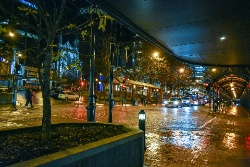State Of Emergency Lifted
The state of emergency has been lifted in Tairāwhiti but widespread damage remains on a sodden and exhausted community.
Gisborne Mayor Rehette Stoltz lifted the state of emergency this afternoon, effective from immediately.
Torrential and persistent rain earlier this week and a less-than-ideal forecast saw the state of emergency declared at 4.45pm on Thursday (June 22). While Tairāwhiti didn’t receive the predicted amount of rain, what did fall still managed to create havoc, with landslides, extensive damage to both the local and state highway roading networks.
Rainfall tallies for the past week tell the tale of the tape, with 565mms at Raparapaririki, inland from Ruatoria, 494mm at the Fernside Station telemetry station, inland from Tokomaru Bay, with a number of other Coast sites in excess of 400mms. Mangapoike recorded 410mms, Waerenga-o-Kuri had 235mms, with the Waipaoa Station receiving 227mms, and Gisborne Airport 185mms.
In the first six months of 2023, Tairāwhiti has had more than its average annual rainfall.
SH2 north has closed until Monday at best with some major cracks in the road at Otoko. SH35 has also been affected with flooding, slips, drop outs and silt closing roads across the network.
River levels also rose during the peak days of the weather event.
Civil Defence group controller Ben Green praised the region for its response. “It’s been great to see the relative calm across all areas,” he said. “We’ve seen regional communities, iwi and emergency services, among others, well prepared and they’ve come together for our people.”
He felt for those who have already been through so much from cyclones Hale and Gabrielle. “They’ve experienced significant impact already, and we are certainly seeing signs of fatigue out there. What does shine through though is the process of how quickly our processes and groups and structures came together as part of readiness and response operations.
Welfare centres – a mixture of Civil Defence and community led, had been made available across Tairāwhiti and were used. Te Karaka had been evacuated early with whānau heading to welfare centres nearby, in town or with friends.
The high ground water table is creating problems that have led to issues with sewage overflow on some city properties, bringing with it health concerns.
Clean-up continues across the region, on the roads, in back yards, schools and more, and residents continue to prepare as best they can for the next weather event. Those who live on hills are asked to keep an eye out for any unusual movement – contact Council if you notice any slumping, cracks, creaking noises, doors sticking in homes or retaining walls leaning. Call 0800 653 800.
The removal of the state of emergency signals there is a shift from the response to the recovery phase.


 Gordon Campbell: On ACT’s Charter Schools Experiment
Gordon Campbell: On ACT’s Charter Schools Experiment NZ Government: Christopher Luxon - Pre-Budget Speech To Auckland Business Chamber
NZ Government: Christopher Luxon - Pre-Budget Speech To Auckland Business Chamber Government: New Zealand Supports UN Palestine Resolution
Government: New Zealand Supports UN Palestine Resolution Green Party: Greens Welcome Cross-party Approach To Climate Adaptation
Green Party: Greens Welcome Cross-party Approach To Climate Adaptation Government: Climate Change – Mitigating The Risks And Costs
Government: Climate Change – Mitigating The Risks And Costs Greenpeace: Protest March Against Fast-track Bill Announced For Auckland
Greenpeace: Protest March Against Fast-track Bill Announced For Auckland Wellington Office of the Mayor: Mayor Responds To Housing Minister’s District Plan Decision
Wellington Office of the Mayor: Mayor Responds To Housing Minister’s District Plan Decision


